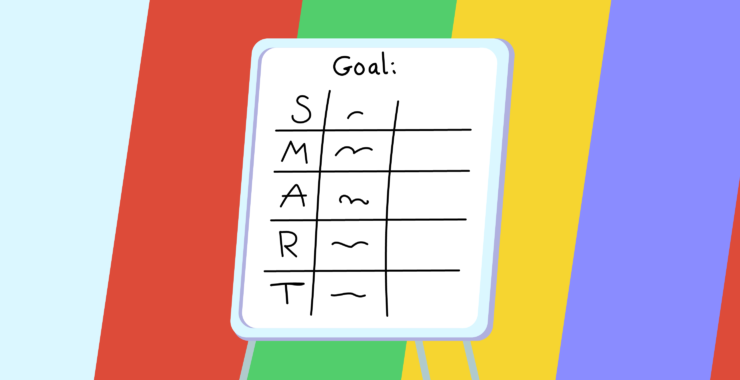Hybrid work is increasingly becoming popular, and as we shift towards more remote work and less face-to-face interaction, there is a risk of employees feeling disconnected and less engaged with their work.
This reduced engagement can lead to demotivation and may signal ineffective management practices.
To keep the team aligned and motivated, adopting SMART goals is a straightforward and efficient method.
In this article, we will discuss the impact of SMART goals on remote teams and provide examples of SMART goals that can be implemented in your workplace.
What are SMART goals?
SMART goals are specific, measurable, achievable, relevant, and time-bound objectives that help to establish clear and attainable targets, making professional communication and collaboration more straightforward.
For instance, instead of a vague goal like “improve customer satisfaction,” a SMART goal would be to “increase the average rating of customer service calls by 10% in the next quarter.”
By using SMART goals, your remote team gains clarity on expectations, how their performance will be evaluated, and the significance of their work.
How to set SMART goals for remote teams?
Adopting SMART goals brings structure and traceability to your objectives, offering a proven method to enhance workforce performance.
By setting measurable targets with clear milestones, you can easily determine when a goal has been accomplished.
SMART objectives enable teams, departments, or individuals to align their goals while considering the broader company objectives.
Consistently tracking these goals ensures that alignment is maintained throughout the entire process.
Working on SMART goals may present challenges, but with dedication and a well-defined strategy, you can undoubtedly achieve each goal you set.
Benchmarking your objectives against past company performance, cross-department analysis, or competitor research helps ensure they remain realistic and achievable.
Here are some ways that can help you establish SMART goals for your remote team.
1. Effective communication
The main factor that leads to the failure of remote teams is poor communication.
In a remote work environment, there is a lack of in-person interactions, making it essential to utilize various digital communication tools to share goals with your remote team.
Nowadays, we have numerous communication platforms like Chanty that make the process a breeze.
However, merely sharing goals with your employees is not enough. Goal setting should be an ongoing process.
Continuously communicate your goals to remote employees using communication tools and make sure they fully grasp the objectives.
2. Flexibility for diverse preferences
In remote teams, members come from different backgrounds and locations, leading to various work styles, preferences, and obstacles.
It is crucial to acknowledge and accommodate these differences rather than enforce a standardized approach.
For instance, you can provide flexibility in working hours, deadlines, and internal tools, as long as they align with your goals and expectations.
Additionally, customize your communication and feedback methods to suit the personality and requirements of each remote worker.
3. Achieving goals effectively
To improve goal achievement, streamline your work process and prioritize tasks related to reaching your goal.
For example, focus on urgent tasks first and then tackle non-important and non-urgent ones later.
Understanding this time management approach can help you stay on track and accomplish your goals.
It’s essential to stay determined and persistent, like legendary football coach Paul Bear Bryant advised, “Never quit. Set a goal and don’t stop until you achieve it. Then, set another goal and keep going. Never quit.”
4. Break down your goals into smaller tasks
When you break down a big objective or business goal into smaller tasks, it becomes easier to track progress and measure success.
These smaller tasks are like milestones or key performance indicators (KPIs), which are measurable outcomes indicating that you are moving closer to achieving the main goal.
For example, in a marketing campaign, two important KPIs could be ROAS (Return on Ad Spend), which tracks how much revenue is generated for every dollar spent on advertising, and Customer Acquisition Cost (CAC), which measures the cost of acquiring a new customer. By breaking down the larger goal of improving overall sales, you can focus on optimizing specific areas to ensure you’re on track.
This approach allows business owners and managers to assess if the goal is being achieved on schedule or if there are challenges that require reevaluation.
By focusing on smaller tasks, it becomes clearer how well the overall goal is being pursued.
5. Encourage employee growth
To keep your employees productive, offer them chances for personal and professional development.
When you align the company’s goals with their personal growth, it benefits both the employees and the organization. Show your employees that enhancing their skills will contribute to the company’s success.
For instance, if there’s less work currently, motivate your employees to use this time for learning and improving their abilities at work.
By taking advantage of this opportunity, you can enhance their skills, leading to a more content and high-performing workforce.
SMART goal examples
Remote professionals thrive on clear and achievable goals to maintain focus, motivation, and productivity in their unique careers.
Using the SMART goal framework, remote employees are empowered to establish well-defined objectives and monitor their progress effectively.
In this section, we’ll explore real-life examples of SMART goals customized for five different remote professions.
These illustrations will showcase how remote professionals can utilize SMART principles to set meaningful and attainable targets, foster personal development, and drive success in their remote work journeys.
SMART goal examples for content writers
- Specific: Increase the number of monthly blog posts to 15.
- Measurable: Track the number of published blog posts each month.
- Achievable: Allocate dedicated time for research and writing.
- Relevant: Improve organic traffic and user engagement on the website.
- Time-bound: Achieve this goal within the next three months.
SMART goal examples for software developers
- Specific: Improve the application’s performance by reducing load time.
- Measurable: Measure the current load time and set a target for improvement.
- Achievable: Collaborate with the development team to optimize code and implement best practices.
- Relevant: Enhance user experience and increase customer satisfaction.
- Time-bound: Achieve a 20% reduction in load time within the next two months.
SMART goal examples for sales representatives
- Specific: Increase monthly sales revenue by 15%.
- Measurable: Track monthly sales and revenue figures.
- Achievable: Implement targeted marketing campaigns and follow-up strategies.
- Relevant: Boost company revenue and contribute to business growth.
- Time-bound: Achieve the sales target within the next quarter.
SMART goal examples for graphic designers
- Specific: Complete five client projects using Adobe Creative Suite.
- Measurable: Keep a record of the number of projects completed.
- Achievable: Manage time efficiently and maintain a schedule for each project.
- Relevant: Deliver high-quality designs that meet clients’ expectations.
- Time-bound: Complete the five projects within the next six weeks.
SMART goal examples for virtual assistants
- Specific: Reduce email response time to less than 24 hours.
- Measurable: Monitor the time taken to respond to each email.
- Achievable: Prioritize urgent emails and use email management tools effectively.
- Relevant: Improve client satisfaction and technical communication efficiency.
- Time-bound: Achieve the reduced response time within the next month.
Tips for effectively achieving SMART goals
Now that you have examples of SMART goals to guide you, we’ve prepared four simple tips to ensure these goals resonate with your team:
- Planning: Every SMART goal needs a well-thought-out plan to go with it. In this plan, you’ll outline key milestones, anticipate possible challenges, and create a schedule.
Remember, measurable outcomes must be the foundation of your objectives, based on criteria like key performance indicators or skill levels. Without this grounding, you risk wasting time and resources.
- Tracking: A good process requires regular updates. Consistency is key, especially when working with a distributed team. SMART goals take time to achieve, so it’s essential to regularly check progress. Remote team management software can help streamline this process, allowing you to monitor progress easily and keep everyone aligned.
Organize regular catch-ups and feedback sessions to stay motivated and on track, especially for more significant goals that span quarters.
- Outline ownership: For your team to achieve their goals, they need a clear vision of success. To achieve this, lay out the process for reaching the target.
Transparency is crucial here, so your team knows:
- Who will do what?
- Do they have the necessary skills, or how can they acquire them?
- How will the resources be allocated?
- What are the timeframes?
- What does success look like?
- Agile: Don’t stay stagnant. SMART goal-setting is an evolving process. The goals you set today may differ from those in a few years, especially in the early stages of a business.
Regularly revisit your SMART goals, updating and adjusting them over time. Avoid vague targets and recognize that not all goals are equal. By doing so, you’ll accurately measure your success and stay on the right track.
- Recognition: Celebrate achievements, even with smaller goals, to boost morale and keep everyone motivated. Acknowledge team members who complete tasks and share their success to inspire others.
Establish a culture of regular recognition to uplift company spirits. You can use a performance management app accessible on mobile devices to ensure that distributed teams benefit from this positive reinforcement.
It’s going time!
whatfix.com
Understanding the process of setting goals for your remote team is crucial for providing clear guidance and maximizing their efforts.
By communicating their expectations and developing collaboration skills, team members can plan their schedules and prioritize tasks effectively.
When everyone comprehends the company’s goals and their roles in achieving them, they can work independently and efficiently toward success.
Clear goals break down virtual barriers, empowering your remote team to boost productivity. Goals benefit everyone involved, including remote managers, employees, leaders, and business associates.
Don’t hesitate; take action now and set meaningful goals for your remote team.








